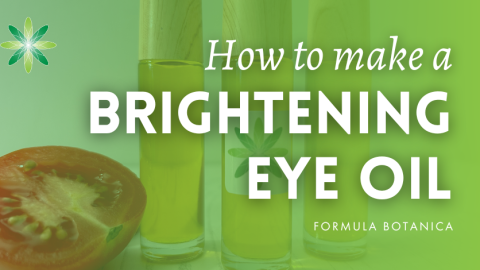Have you ever wanted to know how to use an emulsifier called Vegetal or Montanov 68 in your cosmetic formulations? In this blog series we will introduce you to various emulsifiers so you can start or continue experimenting to create the perfect emulsion.
Emulsions are very popular in conventional and natural skincare not only because of their skin feel but also because they allow both water and oil-soluble ingredients to be included in them.
What is an emulsion?
An emulsion is a blend of water and oil, which are brought together by the use of an emulsifier – creating a homogenous blend. There are many emulsifiers on the market that may be used by natural skincare formulators. They can be oil-in-water or water-in-oil emulsifiers, or they can be hot processed or cold processed (want to learn more about the science of emulsification? Check out our Advanced Diploma in Organic Cosmetic Science)
An oil-in-water (O/W) emulsion is where fine droplets of oil are dispersed through an aqueous base. These O/W emulsions tend to be more liquid, such as milk or a skin cleansing lotion. A water-in-oil (W/O) emulsion is where ultra-fine droplets of water are dispersed throughout the fatty base ingredients. These emulsions tend to be quite thick and greasy.
We often see that many of our students prefer oil-in-water emulsions possibly because they are quite similar to conventional lotions and creams.
Your choice of emulsifier is a personal preference but you need to consider many other factors. Please read one of our previous blogs to help you make a decision on which emulsifier is suitable for you and your product needs.
Introducing Vegetal
In this blog we will introduce you to an easy-to-use and widely available oil-in-water emulsifier called Vegetal. Its other trade names include:
SugarMulse / Glucomulse / Montanov68
Its INCI name is:
Cetearyl Alcohol and Cetearyl Glucoside
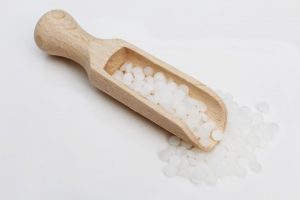
How to use Vegetal in your emulsions
- Solubility: in oil – add to to oil phase
- Process: hot process (70 degrees Celsius)
- Usage: 3-8%
Depending on the oil-to-water ratio and the ingredients you use, you can create wonderful skincare products ranging from thick creams to thinner lotions. We recommend to start experimenting with a 25% oil phase and 6% vegetal and adjust your formula as you go along.
You may add xanthan gum to stabilize the water-phase and you can also add stearic acid, butters or waxes to thicken the emulsion.
You need to heat this emulsifier in the oil-phase to 70-75C. You can easily make emulsions using a mini whisk so there is no need for expensive equipment. If you have Kai Blendia (the hand-held homogeniser we recommend to our students) or a larger lab homogenizer, then you should use those when creating the emulsion. Later on in the cool-down phase you can swap to a mini whisk, so that you won’t destroy the structure of the emulsion.
Our example emulsions with Vegetal
To show you the versatility of this emulsifier, we have created 3 different samples. We used sunflower oil and distilled water in each of them as we wanted to concentrate on the viscosity of the emulsion.
 Sample 1: 30% oil and 8% Vegetal
Sample 1: 30% oil and 8% Vegetal
We used 30% oil together with 8% Vegetal to create a thick and creamy emulsion, with great stability. The higher percentage of oil in the blend is going to mean that the cream feels thicker on the skin and doesn’t behave like a thin lotion. We can easily imagine this cream as a facial night product or even as a hand cream. It leaves the skin very soft and not greasy at all, not something you’d expect from a rich cream.
 Sample 2: 10% oil and 5% Vegetal
Sample 2: 10% oil and 5% Vegetal
We then trialled 10% oil together with 5% Vegetal to create a thinner cream. The final product has a thinner consistency and would work well in an airless packaging. It became a very smooth and shiny cream that can be used for both facial and body skincare. You can imagine using this emulsion for day products, or for younger skin at night.
 Sample 3: 10% oil and 3% Vegetal + 0.2 Xanthan gum
Sample 3: 10% oil and 3% Vegetal + 0.2 Xanthan gum
Finally, we blended together 10% oil with 3% Vegetal. However, we also added 0.2% Xanthan gum to this blend to stabilise it. This cream is the thinnest version of the three samples we made; it could make a lovely day moisturizer or even a nice facial wash with some surfactant added to it. As it is not oily, you can come up with something amazing for oily skin.
As always, before you prepare any new formulations, you should consider what product you want to create, how this emulsifier fits in your brand ethos and experiment, experiment, experiment.
Bonus Sample Formulation with Vegetal
 Calendula and Q10 night cream
Calendula and Q10 night cream
Calendula is a wonderful skin soothing herb which also provides a beautiful orange colour to the finished product. We’ve paired the macerated calendula oil (learn how to make macerated oils here) with Coenzyme Q10 and two beautiful CO2 extracts to make it a luxurious night cream. You will see that we’ve also added shea butter to give the cream additional thickness.
| Phase A: | |
| Shea butter | 5% |
| Apricot oil | 10% |
| Calendula macerate | 5% |
| Jojoba oil | 5% |
| Vegetal | 6% |
|
Phase B: |
|
| Aloe water | 58.3% |
| Glycerin | 5% |
| Xanthan gum | 0.2% |
|
Phase C: |
|
| Vitamin E | 0.5% |
| Coenzyme Q10 | 2% |
| Calendula CO2 extract | 0.5% |
| Sea buckthorn CO2 extract | 0.5% |
| Preservative Eco | 1% |
| Manuka essential oil | 0.2% |
| Lavender essential oil | 0.3% |
| Red Mandarin essential oil | 0.5% |
Method of Manufacture
- Heat Phase A and Phase B in separate glass beakers in a water bath till they reach 75 degrees Celsius. Do not heat and hold your ingredients (not sure why? read this article).
- Pour Phase B into A while using a homogenizer (such as the Kai Blendia) or a whisk. The emulsion will form quickly.
- Remove the blend from the water bath and continue stirring (now use a mini whisk). You can place the beaker in ice water to speed up the cooling process.
- When the temperature of the blend has dipped to below 35 degrees Celsius, you can add Phase C ingredients, blending well after each addition. Check the pH to ensure it is suitable for your preservative. In my example I had to raise the pH a bit.
Now it’s your turn! Purchase a sample of Vegetal and show us the emulsions you made by hashtagging it with #FormulaBotanica on Instagram. If you are new to formulating and want to learn how to emulsify, then enrol today for our Diploma in Organic Skincare Formulation.
Have you ever used Vegetal? What are your formulating experiences? Share with us in the comments below.
FAQs
How do you make natural emulsifiers?
Unless you are an experienced cosmetic formulator, you won’t need to nor wish to make natural emulsifiers. You can easily purchase natural emulsifiers as complete ingredients; some well-known ones available include Vegetal, Montanov™ 68 and Polyaquol 2W. You then use the emulsifier to create your choice of emulsion which can be oil-in-water, where the oil component is encapsulated in a water base in the formulation; or a water-in-oil emulsion in which the water is emulsified and homogenised into oil base of the product. The role of an emulsifier is therefore to bind oil and water, two chemical ingredients which do not bind naturally, into a homogeneous, smooth cosmetic emulsion.
What is the best natural emulsifier?
There are a lot of natural emulsifiers on the market available to the home and indie beauty formulator. However, there is no single best emulsifier to suits all types of emulsion formulation. There are numerous factors you need to think about when choosing a natural emulsifier such as whether you wish to create an oil-in-water or water-in-oil emulsion, whether you need to apply heat in the manufacturing process and therefore require a hot- or cold-process emulsifier, and also the desired skin feel and use of the final cosmetic product. Research natural emulsifiers that are best for your specific cosmetic and then do your homework on those you have the experience and equipment to work with. Some emulsifiers need high sheer blending while other perform well being hand whisked.
Where can I learn to formulate natural skincare and haircare?
Join us at Formula Botanica, where tens of thousands of students and followers take our free and paid online courses to learn how to formulate organic skincare and haircare for themselves or to sell and also how to set up a beauty brand and business.
FREE TRAINING
Learn how to become an
Organic Skincare Formulator
FREE TRAINING
How to become an
Organic Skincare Entrepreneur
FREE TRAINING
How to become an
Organic Skincare Entrepreneur
Leave us a comment

Timi was a key member of the Formula Botanica team from 2015 to 2020; first as our Education Manager and then as Head of Formulation & Research. You can find out more about the Formula Botanica team here.


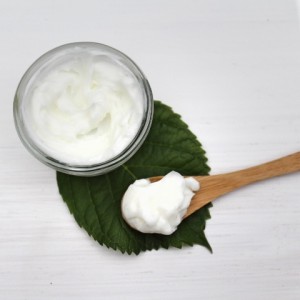 Sample 1: 30% oil and 8% Vegetal
Sample 1: 30% oil and 8% Vegetal Sample 2: 10% oil and 5% Vegetal
Sample 2: 10% oil and 5% Vegetal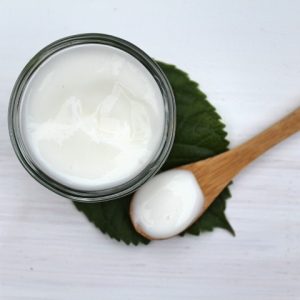 Sample 3: 10% oil and 3% Vegetal + 0.2 Xanthan gum
Sample 3: 10% oil and 3% Vegetal + 0.2 Xanthan gum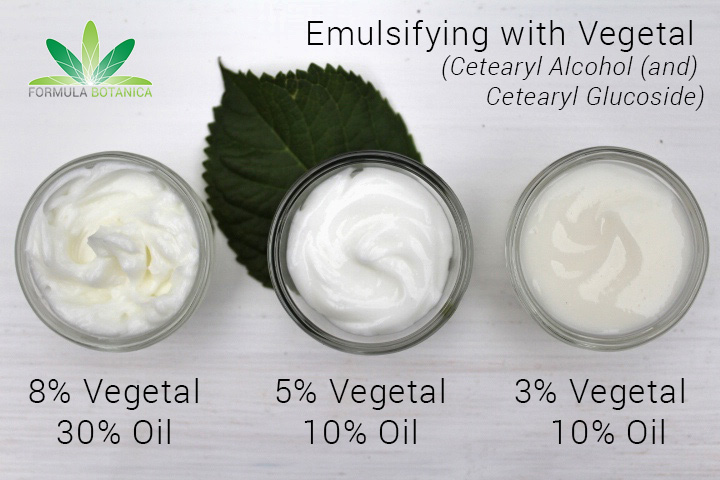
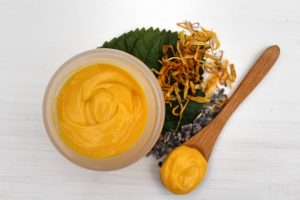 Calendula and Q10 night cream
Calendula and Q10 night cream




